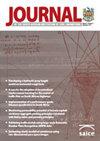混凝土结构中透氧指数值的可变性:一种用于指导混凝土混合料设计的参数裕度方法
IF 0.6
4区 工程技术
Q4 ENGINEERING, CIVIL
Journal of the South African Institution of Civil Engineering
Pub Date : 2022-09-14
DOI:10.17159/2309-8775/2022/v64n3a1
引用次数: 1
摘要
基于施工早期混凝土性能测试的耐久性规范正在全世界获得认可。在南非,耐久性指数(DI)方法已被当地规范所接受。这给建筑项目的混凝土混合料设计带来了挑战,该设计考虑了材料和测试条件的可变性,以确保混凝土在现场样品上进行DI测试时达到规范要求。本文提出了一种统计方法,用透氧指数(OPI)测试来解释混凝土混合料设计中的这种可变性,这种方法承认了实验室和现场样品测试的可变性。南非国家公路局有限公司(SANRAL)在实际施工项目中对名义上类似的混凝土获得的OPI测试结果,包括基于DI的规范,用于说明拟议方法的操作。结果表明,在混凝土混合料设计中要实现的OPI目标值受到施工现场质量控制水平的影响,但这可以通过适当的统计方法进行管理。本文章由计算机程序翻译,如有差异,请以英文原文为准。
Variability of oxygen permeability index values in concrete construction: A proposed approach for parameter margins to guide concrete mixture design
Specifications for durability that are based on performance tests on concrete during the early stages of construction are finding acceptance throughout the world. In South Africa the durability index (DI) approach has been accepted into local specifications. This raises a challenge in the design of a concrete mixture for a construction project that takes account of the variability in materials and test conditions to ensure that the concrete will achieve the specification requirements when subjected to DI testing on in-situ samples. This paper proposes a statistical approach to accounting for this variability in concrete mixture design with oxygen permeability index (OPI) testing, in a manner that acknowledges the variability of both laboratory-based and in-situ sample testing for compliance. The OPI test results obtained on nominally similar concretes on actual construction projects undertaken by the South African National Roads Agency Limited (SANRAL), which included the DI-based specifications, were used to illustrate the operation of the proposed approach. The results show that the target value of OPI to be achieved in the design of concrete mixtures is influenced by the level of quality control on construction sites but that this can be managed through an appropriate statistical approach.
求助全文
通过发布文献求助,成功后即可免费获取论文全文。
去求助
来源期刊
CiteScore
0.70
自引率
25.00%
发文量
19
审稿时长
>12 weeks
期刊介绍:
The Journal of the South African Institution of Civil Engineering publishes peer reviewed papers on all aspects of Civil Engineering relevant to Africa. It is an open access, ISI accredited journal, providing authoritative information not only on current developments, but also – through its back issues – giving access to data on established practices and the construction of existing infrastructure. It is published quarterly and is controlled by a Journal Editorial Panel.
The forerunner of the South African Institution of Civil Engineering was established in 1903 as a learned society aiming to develop technology and to share knowledge for the development of the day. The minutes of the proceedings of the then Cape Society of Civil Engineers mainly contained technical papers presented at the Society''s meetings. Since then, and throughout its long history, during which time it has undergone several name changes, the organisation has continued to publish technical papers in its monthly publication (magazine), until 1993 when it created a separate journal for the publication of technical papers.

 求助内容:
求助内容: 应助结果提醒方式:
应助结果提醒方式:


